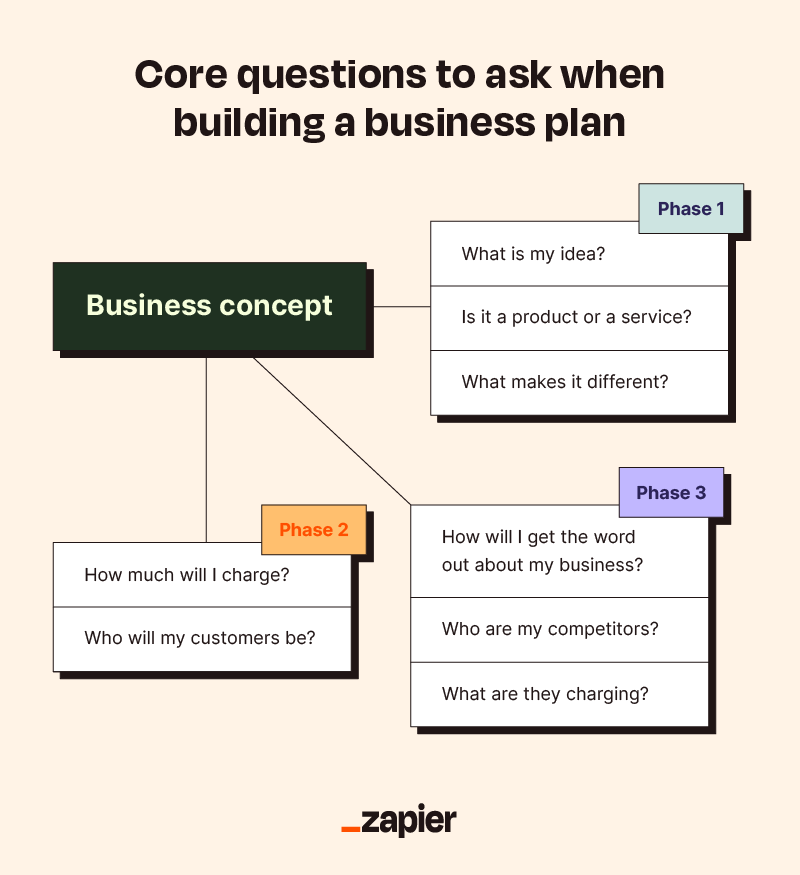I wrote my first business plan when I was six. I've learned a lot since then, and in hindsight, I can see why the investors around my family's Christmas table didn't take my space Marine cowboy ranch pitch seriously. I didn't put a lot of thought into what it would take to make the idea work, and I certainly didn't do the market research. Also, it was a space Marine cowboy ranch business.
My point is that thinking about the outcome before considering the many variables that pave the way is counterproductive. A business plan may not seem like the most critical or complicated document, but it can guide an entire organization, keeping success at the top of everyone's mind. It's the difference between a successful investor pitch and crying on Christmas.
To show you what I mean, I've put together a simple business plan template to get you started.
Table of contents:
Simple business plan template + example

This simple business plan template outlines key business objectives, strategies, and financial projections. Compiling this information into one document will not only prepare you for the realities of running a business but will also guide your team, business partners, and investors as they navigate the plan.
After some good old-fashioned data entry, you should have a polished business plan that's ready to share. Regardless of what stage your business is in, this template is flexible enough to accommodate your needs.
Here's a business plan example I put together using the template above, to give you an idea of what it might look like once it's complete.
What is a business plan?
A business plan is a document that clearly defines your company's goals, strategies, and operational details. It's essentially a roadmap for your team and investors. Think of it as boiling your entire business (concept, vision, dreams, and everything in between) down to one document.
A formal business plan will include an overview of your products or services, marketing and sales strategies, targeted markets, financial details, and even a description of what you're building.
Of course, business plans are unique snowflakes, so there's no one size fits all. Depending on what you're trying to do—attract investors, guide project expansion, align team members—your plan will look a little different. I'll dig into the different types of business plans in a bit.
What makes a business plan so important?
In its simplest form, a business plan turns your concept into a reality. In more tangible terms, it also helps you achieve necessary business goals like securing funding. You'll have a hard time finding investors if you show up to a pitch meeting with only a winning smile and a can-do attitude—a strong business plan can show them a clear path to a return on their investment.
Investors and their judgmental silence aside, this document is critical for guiding internal decision-making, setting goals, and providing a clear direction for the business and its vision.
Key components of a business plan
Before your business partners can understand your vision, you need to make sure you do. Before you start putting your business plan together, ask yourself whether your idea is feasible, whether it's different from what's already out there, if there are any competitors, and if they're doing something unique. Also consider your prices and customer base.

You likely already know most of the answers to these questions. My Christmas pitch all those years ago could have gone differently if I'd put crayon to paper and answered these questions myself. My family couldn't follow my spur-of-the-moment speech, and neither will your team or investors—they need it spelled out as clearly as possible.
While no two business plans will look the same, there's a handful of key components virtually all good business plans have in common. So, if you haven't already looked through the template with the optimism that my six-year-old self lost that Christmas, here's what you can expect to find.
Title page: Impress readers with a unique presentation. This is your first opportunity to showcase your brand.
Table of contents: No one likes being lost in a document. A TOC can help readers navigate the various sections and get an overview of what's inside.
Executive summary: Provide an overview of the business, summarizing its mission, goals, and key highlights.
Market analysis: Include your research and data on the target market. Make sure to outline industry trends, competition, and customer demographics.
Products/services: Detail your services or products. You'll want to expand on your unique selling points and customer benefits.
Marketing and sales strategy: Outline your plans for promoting your business. If you've already identified marketing and sales channels, include those, too.
Financial plan: Define all financial details, from required funding and business budget to projected income and profit.
The organization: Showcase how your business will function on a structural level. Make sure to talk about your team's different positions and functions, and how it will all be managed.
Types of business plans
Let's say you have a well-established construction manufacturing business. If you're looking to expand the business into a new location, you don't want to repurpose the same simple startup business plan. You'd want to build on it (pun intended) with an expansion business plan.
Unlike your original business plan, which outlined your original milestones and goals, an expansion plan would include an analysis of your expansion and its development, purpose, feasibility, market, and reasoning. It would still outline your overarching goals for the business as a whole, but with additional information about the expansion and what that entails.
And that's just the tip of the iceberg. For example, internal and strategic business plans serve an internal purpose. These are the types that are written for your team rather than your business partners. They're created to pin down the long-term game plan and keep team members aligned.
Not all businesses are in the same stage, so be sure to find a business plan that fits your current needs. A new startup's checklist is different from that of an expanding business, and so is its business plan.
| Startup business plan | Internal business plan | Strategic business plan | Expansion business plan | Feasibility business plan |
|---|---|---|---|---|---|
Use | External | Internal | Internal | Internal & external | External |
Contents | Business concept, strategy, and financial projections | Specific projects, departments, and initiatives | SWOT analysis, mission, vision, and objectives | Strategies, resources, new product lines, new markets | Market research, financial projections, and potential risks |
Purpose | - Early-stage planning
- Securing funding and investors | - Aligning team members
- Allocating resources effectively | - Defining long-term goals
- Guiding the overall strategic direction | - Outlining expansion plans and timelines
- Defining new markets and growth opportunities | - Assessing the viability of a business idea
- Determining if the business concept is worth pursuing |
Making the business plan template your own
A business idea and a feasible business plan are two very different things. Follow these steps to solidify your ideas into a clear roadmap.
1. Define your mission statement
A mission statement is a way for you to tell your company's story and communicate the vision you have for it. It should reflect your values, goals, and what you hope to achieve, setting the tone for your entire business plan. Ask yourself if your mission statement makes your business sound credible, feasible, and profitable.
2. Outline a detailed company description
Don't be shy about the details. Provide your readers with a comprehensive overview of your company, its history, founders, legal structure, location, and the concept it's all built around. You might even include photos and illustrations for an extra flair.
3. Set your business goals
Set out your short- and long-term business goals. Be as specific as you can, and use the SMART technique, outlining goals that are specific, measurable, achievable, relevant, and timely. Make sure these goals align with your mission statement.
4. Detail your services/products
Describe your services or products and lean heavily on their unique selling points. Discuss benefits, features, and the problems they solve for the target market you're aiming to reach. Include some visuals of your product or service to really drive the point home.
5. Analyze your target audience
Describe the market you're targeting and the audience demographics you've identified in your research. Understanding your future customers is essential for marketing and sales strategies. Put together ICPs to define your ideal customer base and create buyer personas to keep your team on track.
6. Set milestones for marketing and sales
Showcasing that you've identified your target audience isn't enough. You need to prove that you know how to speak to it and how to appeal to it while promoting your products and services. Some businesses set up milestones such as X amount of sales, Y number of acquired clients, or, in my case, the successful integration of Cowboy Ranch into the International Space Station.
7. Perform a financial analysis
Conduct a thorough financial analysis that includes details such as income statements, balance sheets, and cash flow statements. Outline your financial projections and your funding requirements. This section should prove how financially feasible your business concept is.
Once you have these points outlined and fleshed out, it's only a matter of representing each and every one of them in detail, ensuring that the voice and tone of your business plan reflect your brand and embody the unique concept you want to get across.
Future-proofing your business plan
In summary: investors are not mind readers, and cowboys should stay on Earth.
Your business plan is the sum of your ideas, passion, vision, and the lessons you learn as your business develops. Over the years, it will likely go through a few iterations and changes, but the plan you write today will guide you through the beginning stages.
As your business plan grows out of its infancy, you can start looking into other useful tools like revenue growth plans to start preparing for the challenges ahead. And when those challenges come, Zapier can help growing businesses like yours tackle them with no-code automation that scales with you.
Related reading:






